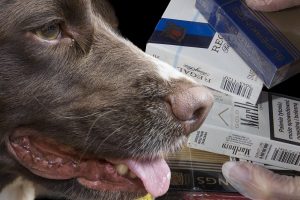PUBLISHED:
09.03.2020 Springer spaniel, Billy, excitedly paws at the false wall behind the shop counter that has been put in place to conceal hundreds of fake cigarettes.
Springer spaniel, Billy, excitedly paws at the false wall behind the shop counter that has been put in place to conceal hundreds of fake cigarettes.
As far as he’s concerned, he’s just sniffed out his favourite toy, and is indicating to his handler that it’s time to play.
His many months of training – as well as years of continual on-the-job development – have taught him to associate his toy with the smell of tobacco.
For him, it’s all just a game.
What he doesn’t realise is that he’s just successfully rid the streets of dangerous illegal cigarettes – and potentially led to another criminal being put behind bars.
The scene is one that plays out up and down the UK every week, as highly skilled detection dogs from Wagtail lead raids with Trading Standards departments and police forces to sniff out illegal substances.
Wagtail dogs have sniffed out millions of illegal cigarettes and hundreds of thousands of pounds in cash in the past few weeks alone.
The process of training our dogs to successfully carry out such raids is a rigorous one.
Wagtail dog handling instructor, Kevin, explains.
“We generally recruit potential detection dogs between the ages of 12 months and 3 years of age,” he says.
“We initially look for a number of qualities, including being physically fit and agile with good confirmation; a natural hunting instinct, in particular high prey drive; natural confidence and contentment in most reasonable environments, and a natural drive to investigate independently and willingness to please.”
The first stage of the training process is a 14-day trial, which assesses the dog’s natural qualities, instincts and behaviours, before culminating in a health check and X-ray by a vet.
Kevin says: “The dog has got to demonstrate confidence in most reasonable environments and the ability to hunt for between 3-5 minutes independently.
“There are no set tests, with the trial being a continual assessment conducted and observed by our experienced staff.
“The potential dog is also assessed on its suitability to live in a kennel environment and also its reaction to travelling in a vehicle.”
The timescale from new dog to fully trained detection dog depends on the role they are being trained for.
Wagtail dogs are trained for specific roles which may involve a number of similar odours within that role. They include tobacco and cash detection (tobacco and cigarettes/Sterling, Euros &US Dollars); drug and cash detection (Cocaine, Heroin, MDMA, amphetamine, Ketamine & Cannabis); explosive detection (up to 12 different explosive odours), and live body detection.
“Careful consideration is made before deciding which role a specific dog is suited to and training is tailored to the individual dog and their needs,” says Kevin.
“They have to meet certain standards throughout their training, and it is a straight pass or fail on each test, although some dogs progress quicker than others as training is tailored for each individual dog.
During initial training, dogs will have to demonstrate their ability in a range of disciplines, including fitness conditioning and control work; odour identification and distracting odours; search patterns on Wagtail training areas and live environments, and increased odour soak time.
Kevin says that, after final assessments, dogs will be sent on operations as a third dog where they can be fully assured with an experienced operational dog before going out alone.
All Wagtail dogs are housed in designated heated kennels, with fully trained kennel staff whilst working as operational detection dogs.
A typical day consists of morning exercise, both group and one on one, to enhance their fitness, conditioning and control work.
Kevin says: “Their days also include specific search, involving lots of journeys in a vehicle and exposure to all manner of environments. It may also involve meeting members of the public.
“During the week, the dogs will be taken on an adventure walk where they can have the opportunity to explore rivers and at the seaside, all in the vicinity of the Dee estuary and the North Wales coastline.
“They also enjoy an exercise period prior to settling before feed time.”
A typical rest day is filled with fun and exercise.
Kevin says: “Rest days start with morning exercise, consisting of both group and one on one. They will then be put into groups and spend the day rotating through holding pens and large secure open spaces, where they can socialise with their mates and have lots of fun and games.
“Late afternoon they are settled in their kennel prior to having their food.
“All of our Wagtail dogs are classed as working dogs and stay in kennels. They are all teamed with a handler, which enables us to provide the customer a trained dog and trained handler who are both competent and efficient in their specific role.”
At Wagtail, the welfare of our dogs is crucial, even when they retire. A decision on retirement age is made on an individual case-by-case basis, but is typically around six-years-old. Wagtail works closely with Red Paw Rehoming, which specialises in the rehoming of retired detection dogs, to ensure they all go on to loving homes once they have finished working.
